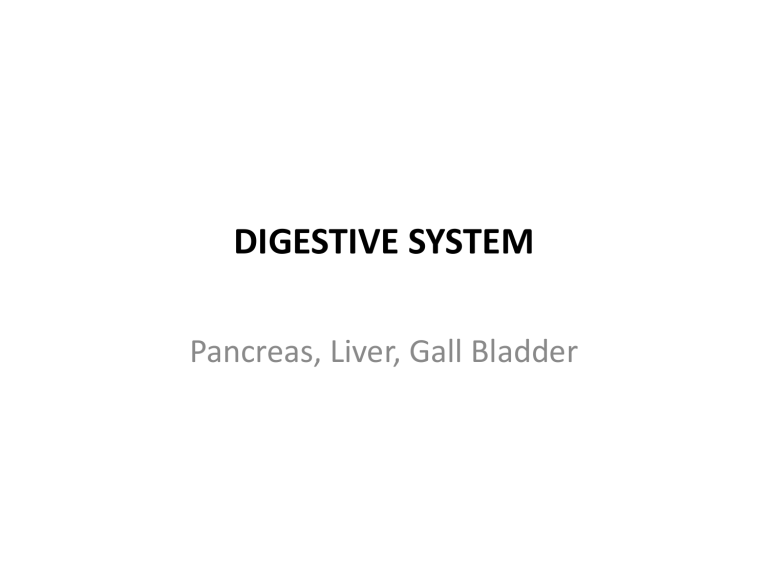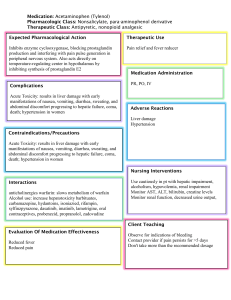
DIGESTIVE SYSTEM Pancreas, Liver, Gall Bladder Pancreas • An elongated retroperitoneal gland • About 12–15 cm (5–6 in.) long and 2.5 cm (1 in.) thick. • Lies posterior to the greater curvature of the stomach, somewhat obliquely, sloping from the head upwards towards the tail on the posterior abdominal wall. • Crosses the bodies of L1-L2 vertebra at the level of the transpyloric plane. • 4 Parts: Head, Neck, Body and Tail. • Head: The expanded and broadest portion of the pancreas embraced by the C-shaped curve of the duodenum. - Uncinate process: A hook-shaped projection from the inferior part of the head, extends medially to the left, posterior to the SMA. • Neck: is short (1.5–2 cm) and overlies the superior mesenteric vessels, which form a groove in its posterior aspect. Anteriorly, covered with peritoneum, and is adjacent to the pylorus of the stomach. • Body: Continues from the neck and lies to the left of the superior mesenteric vessels, passing over the aorta and L2 vertebra, continuing just above the transpyloric plane posterior to the omental bursa. • Tail: Passes anterior to the left kidney The tail is relatively mobile and lies within the two layers of the splenorenal ligament and thus reaches the hilum of the spleen with the splenic vessels. Pancreatic Ducts • Main pancreatic duct: Begins in the tail, runs through the parenchyma of the head. The main pancreatic duct and common bile duct unite to form the short, dilated hepatopancreatic ampulla (of Vater), which opens on an elevation of the duodenal mucosa known as the major duodenal papilla. Sphincter of the hepatopancreatic ampulla (sphincter of Oddi): consists of smth muscle which regulate the passage of pancreatic juice & bile into the through the hepatopancreatic ampulla. • Accessory pancreatic duct: Opens into the duodenum at the summit of the minor duodenal papilla, about 2.5 cm (1 in.) superior to the hepatopancreatic ampulla. Function: - produces enzymes to digest all categories of digestible foods. - Alkaline fluid(bicarbonate) -Secretes insulin and glucagon introduced with enzymes to egulate blood sugar level. neutralizes acidic chyme Histology of the Pancreas • The pancreas is made up of small clusters of glandular epithelial cells. • Exocrine portion: Consists of about 99% of the clusters, called acini. The cells within acini secrete pancreatic juice(a mixture of fluid and digestive enzymes ) through duct system • Endocrine portion: Consists of 1% of the clusters, called pancreatic islets (islets of Langerhans). - These cells secrete the hormones glucagon, insulin, somatostatin, and pancreatic polypeptides into the circulation (blood vessels) to circulate to target cells Blood supply Splenic artery, which supplies the neck, body and tail. Superior and inferior pancreaticoduodenal arteries: supply the head. Venous return: - by small veins into the splenic vein. - superior pancreaticoduodenal vein drain the head into the portal vein - Inferior pancreaticoduodenal vein drain the head into the superior mesenteric vein. Lymph drainage • To the left of the neck it drains into the pancreaticosplenic nodes which accompany the splenic artery. • The head drains from its upper part into the coeliac group and from its lower part and uncinate process into the superior mesenteric group of preaortic lymph nodes. Nerve supply • Parasympathetic vagal fibres: from the posterior vagal trunk and coeliac plexus which are capable of stimulating exocrine secretion. But hormonal control is more important than the neural. • Sympathetic vasoconstriction: spinal cord segments T6–10 via splanchnic nerves and the coeliac plexus Liver • Largest gland in the body, weighs about 1500 g and receives about 1500 mL of blood per minute. • Wedge-shaped, & • lies inferior to the diaphragm and occupies most of the right hypochondriac and part of the epigastric regions of the abdominopelvic cavity. Almost completely covered by visceral peritoneum NB: Of all the organs of the body It is second only to the skin in size. • 2 surfaces • Diaphragmatic: - boldly convex and subdivided into anterior, superior, posterior and right surfaces • Visceral: Has Hilum of the liver( porta hepatis); a transverse fissure is located for entry and exit of HPV, HA, lymphatics, hepatic nerve plexus and hepatic ducts. . Border • Sharp inferior border: Separates the right and anterior surfaces from the visceral surface • Ligaments: Falciform ligament - a fold of the mesentery, extends from the undersurface of the diaphragm btw the two principal lobes of the liver to the superior surface of the liver, helps to suspend the liver in the abdominal cavity. • Ligamentum teres (round ligament): Attached to the free margin of the falciform ligament, a remnant of the umbilical vein of the fetus, carried well-oxygenated and nutrient-rich blood from the placenta to the fetus, this fibrous cord extends from the liver to the umbilicus. • Ligamentum venosum: A fibrous remnant of the fetal ductus venosus, which shunted blood from the umbilical vein to the IVC, short-circuiting the liver. • Coronary ligaments(Rt & lft): narrow extensions of parietal perioneum. Lft forms lft triangular ligament which enclose the bare area, and rt forms rt triangular ligament . • Fxn. The liver’s digestive Bile salts. Bile lack enzymes but function is to produce bile. its bile salts emulsify fats by • Bile: is a yellow-green, physically breaking large fat globules into smaller ones, thus watery solution containing providing more surface area for bile salts, bile pigments, cholesterol, phospholipids, the fat-digesting enzymes to & a variety of electrolytes. work on. • Lobes Anatomical divisions include- a large Right lobe and a smaller Left lobe demarcated by the falciform ligament anteriorly and the fissures for the ligamentum teres and ligamentum venosum on the visceral surface. Caudate lobe: Lies between the inferior vena cava and the fissure for the ligamentum venosum. Quadrate lobe: Lies between the gallbladder fossa and the fissure for the ligamentum teres. NB: Both lobes were consequently considered to be part of the right lobe. Functional division: into right and left halves is by an oblique plane that runs through the centre of the bed of the gallbladder and the groove for the IVC. Bile Produced by hepatocytes Composition Bile salts Bile pigment (mostly bilirubin from the breakdown of hemoglobin) Cholesterol Phospholipids Electrolytes Role of the Liver in Metabolism Several roles in digestion Detoxifies drugs and alcohol Degrades hormones Produce cholesterol, blood proteins (albumin and clo tting proteins) Plays a central role in metabolism Histology of the liver • Hepatocytes: - are the major functional cells and perform a wide array of metabolic, secretory, and endocrine functions. • - Are specialized epithelial cells with 5 to 12 sides that make up abt 80% of the volume of the liver. They secrete bile(which serves as both an excretory product and a digestive secretion.) - Hepatic laminae: are plates of hepatocytes one cell thick bordered on either side by the endothelial-lined vascular spaces(hepatic sinusoids). The hepatic laminae are highly branched, irregular structures. • Bile canaliculi: Are small ducts between hepatocytes that collect bile produced by the hepatocytes. From bile canaliculi – bile ductules - bile ducts. The bile ducts merge to form the larger right and left hepatic ducts, which unite and exit the liver as the common hepatic duct. • Hepatic sinusoids: - Are highly permeable blood capillaries between rows of hepatocytes that receive oxygenated blood from branches of the hepatic artery and nutrient-rich deoxygenated blood from branches of the hepatic portal vein. - Hepatic sinusoids converge and deliver blood into a central vein - hepatic veins - IVC - Stellate reticuloendothelial (Kupffer) cells: Are fixed phagocytes lining the hepatic sinusoids which destroy worn-out white and red blood cells, bacteria, and other foreign matter in the venous blood draining from the gastrointestinal tract. • Portal triad: Constitute a bile duct, branch of the hepatic artery, and branch of the hepatic portal vein. • Biliary tract - The extrahepatic biliary tract consists of the 3 hepatic ducts (right, left and common), the gallbladder and cystic duct, and the common bile duct. • • And portal triad located at 3 corners of the hexagon. NB: Model is based on description of liver of adult pig 3 Anatomical and functional units: Organization of hepatocytes, bile duct system, and hepatic sinusoids. • 1. Hepatic lobule: Each lobule shaped like a hexagon with a central vein, rows of hepatocytes and hepatic sinusoids radiate out from the central vein. 2. Portal lobule:- is triangular in shape and is defined by three imaginary straight lines that connect 3 central veins that are closest to the portal triad(center). - the bile duct of a portal triad is taken as the center of the portal lobule. - This model emphasized the This model has not gained exocrine function of the liver, that is, bile secretion. widespread acceptance. 3. Hepatic acinus:- the preferred structural and functional unit of the liver. - oval mass that includes portions of two neighboring hepatic lobules. - the short axis of the hepatic acinus is defined by branches of the portal The long axis of the acinus is triad that run along the defined by two imaginary curved lines, whichconnect the border of the hepatic two central veins closest to the lobules. short axis Blood supply • Arterial (oxygenated) blood is furnished by the hepatic artery • Venous blood is carried to the liver by the portal vein. • 3 main hepatic veins drain into IVC. • The lymphatics of the liver drain into 3 or 4 nodes that lie in the porta hepatis (hepatic nodes). • Nerve supply: - Sympathetic; by way of the coeliac ganglia - vagus; fibres form hepatic branch reach porta hepatis Functions of the Liver • Lipid metabolism • Protein metabolism • Processing of drugs and hormones • Excretion of bilirubin • Synthesis of bile salts • Storage: prime storage site for certain vitamins (A, B12, D, E, and K) and minerals (iron and copper), which are released from the liver when needed elsewhere in the body. • Phagocytosis • Activation of vitamin : The skin, liver, and kidneys participate in synthesizing the active form of vitamin D. • Carbohydrate metabolism. Gallbladder • a globular or pear-shaped viscus, abt 7–10 cm long, with a capacity of about 50 mL. • lies in the gallbladder fossa on the visceral surface of the right lobe of the liver, adjacent to the quadrate lobe. • Function: Stores and concentrates the bile secreted by the liver • 3 Parts: fundus, body and neck. The neck continues into the cystic duct. • • • - Histology of the gallbladder a fibromuscular sac Mucous membrane: - is a lax areolar tissue lined with a simple columnar epithelium. Epithelium Body: Epithelium is projected into folds which produce a honeycomb appearance Neck and Cystic duct :folds are arranged in a more or less spiral manner (the ‘spiral valve’ of Heister). The epithelial cells actively absorb water and solutes from the bile and concentrate it. Mucus is secreted by the columnar epithelium No goblet cells Mucus secreting glands are present only in the neck. Blood supply • Cystic artery: a branch of the right hepatic which runs across the triangle formed by the liver, common hepatic duct and cystic duct (Calot's triangle), to reach the gallbladder. • Multiple small veins in the gallbladder bed into hepatic veins, one or more cystic veins drain the neck into right branch of portal vein. • Lymph drainage: Drain to nodes in the porta hepatis - and to a node situated at the anterior boundary of the epiploic foramen. From these nodes lymph passes to the coeliac group of preaortic nodes.







